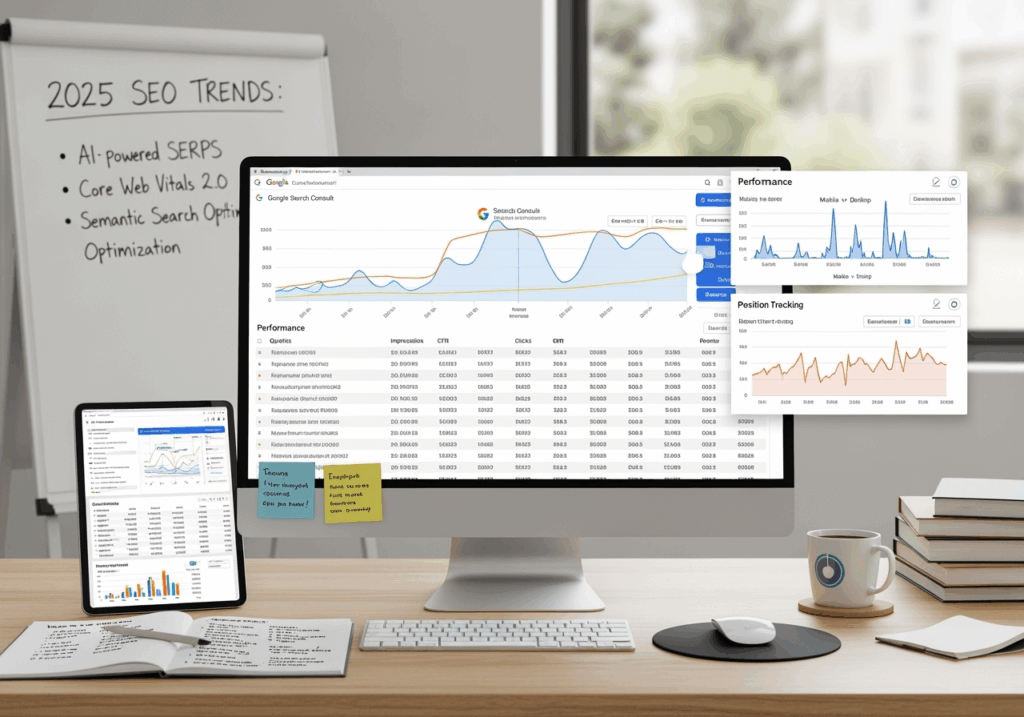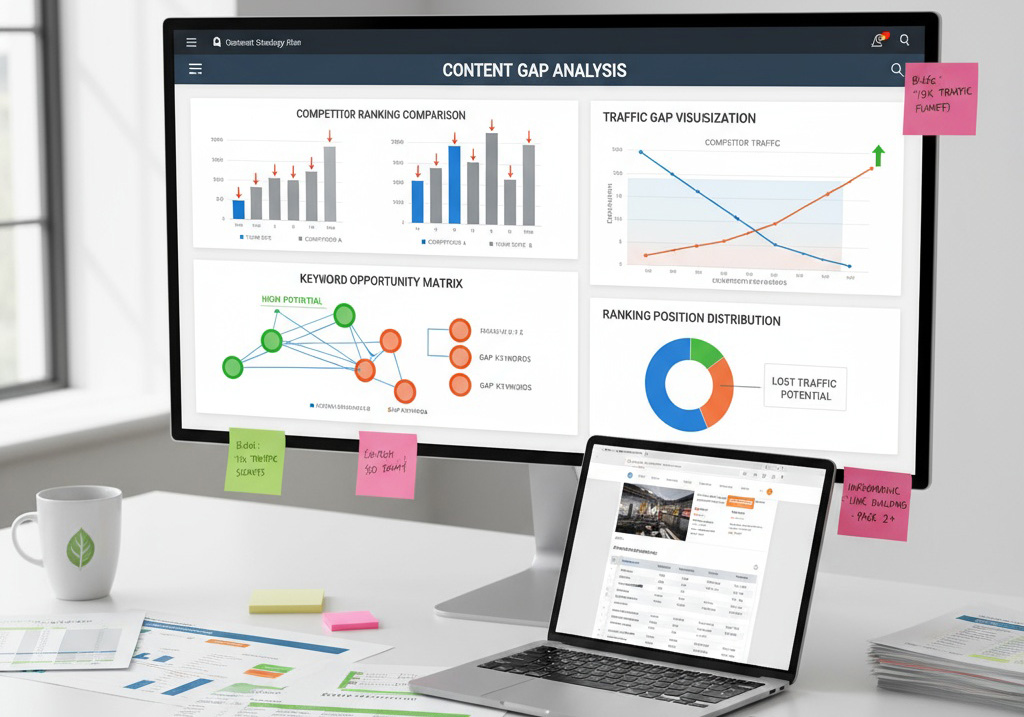Google Search Console keyword research is one of the most underutilised SEO strategies for growing organic traffic. While most marketers know GSC as a site monitoring tool, it’s a goldmine for discovering high-value keywords, long-tail keyword opportunities, and content optimisation insights that can dramatically improve your search rankings.
This comprehensive guide reveals how to leverage Google Search Console data to uncover profitable keywords, optimise underperforming content, and identify easy wins that competitors often miss.
Why Google Search Console Is Essential for SEO Keyword Research
Search Console keyword data provides unique insights that traditional keyword research tools can’t offer. Unlike external tools that estimate search volumes, GSC shows you the exact organic search queries driving traffic to your website, along with crucial performance metrics like click-through rates, average positions, and search impressions.
Key advantages of using GSC for keyword discovery:
- Real performance data from your actual website traffic
- Identifies keyword gaps in your current content strategy
- Reveals search intent patterns specific to your audience
- Shows SERP position tracking for every query
- Completely free alternative to expensive keyword tools
Method 1: Discover High-Value Keywords to Amplify Your SEO Strategy
High-performing keywords are the foundation of successful SEO campaigns. These terms already drive substantial organic traffic to your site, making them prime candidates for content expansion and keyword clustering strategies.
Navigate to the “Search results” tab under “Performance” in your Google Search Console dashboard. This GSC performance report displays four critical metrics:
- Total clicks: Direct traffic from organic search results
- Total impressions: How often your pages appear in SERPs
- Average CTR: Click-through rate indicating content relevance
- Average position: Your ranking performance across queries
Scroll to the “Queries” section and sort by “Clicks” to identify your top-performing keywords. These high-traffic terms represent proven opportunities for related keyword expansion.
Expanding Your Keyword Strategy with Related Terms
Once you’ve identified high-value keywords, use them as seed terms for discovering semantic keywords and long-tail variations. Tools like Semrush’s Keyword Magic Tool can reveal hundreds of related opportunities.
For example, if “best restaurants in Miami” drives significant traffic, explore variations like:
- “top Miami restaurants 2025”
- “Miami restaurant recommendations”
- “where to eat in Miami Beach”
Avoid keyword cannibalization by ensuring each piece of content targets distinct search intent. Create content that serves different user needs rather than competing for identical queries.
Method 2: Optimize Underperforming Keywords for Quick SEO Wins
Underperforming keywords represent your biggest SEO opportunities. These are queries where your content appears in search results (high impressions) but fails to attract clicks (low CTR), typically because you’re ranking on pages 2-3 of Google.
Since 68.7% of clicks go to the top 3 organic results, improving these striking distance keywords can dramatically increase your organic traffic.
In your GSC “Search results” report, sort queries by “Impressions” in descending order. Focus on a recent 3-month period to identify currently relevant underperforming content.
On-Page SEO Optimization Techniques for Better Rankings
Target keywords ranking in positions 11-30 for optimization:
- Title tag optimisation: Include primary keywords in compelling titles
- Content quality improvement: Analyse top-ranking competitors and create superior content
- Meta description enhancement: Write compelling descriptions that improve CTR
- Header tag optimization: Use keywords in H1, H2, and H3 tags naturally
- Internal linking: Connect related content to boost page authority
Use tools like Semrush’s Domain Overview to quickly filter keywords by position ranges and identify the most promising optimisation opportunities.
Method 3: Capture Low-Hanging Fruit Keywords for Immediate Results
Easy win keywords are perhaps the most overlooked opportunity in SEO. These are queries that your unoptimized pages already rank for naturally, meaning minimal effort can yield significant improvements.
In GSC, navigate to the “Pages” tab within “Search results” to see individual page performance. Click on specific pages to view all queries they rank for.
Look for pages with:
- High impressions but low clicks
- Rankings for multiple related queries
- Secondary keyword opportunities that align with existing content
Content Optimisation Strategy for Maximum Impact
When optimising for low-hanging fruit keywords:
- Incorporate target keywords naturally into existing content
- Add relevant LSI keywords and semantic variations
- Improve user experience signals like page load speed and mobile responsiveness
- Enhance content depth by answering related questions
- Optimise featured snippet opportunities by structuring content clearly
Ensure keyword additions feel natural and maintain content quality to avoid over-optimisation penalties.
Tracking SEO Performance and Measuring Keyword Research Success
SEO performance monitoring is crucial for validating your keyword research efforts. Google Search Console’s “Overview” page provides essential metrics for tracking progress.
Key performance indicators to monitor:
- Organic traffic growth: Total clicks over time
- Search visibility: Impression trends and average positions
- Click-through rate improvements: Better CTR indicates relevance
- Keyword ranking improvements: Position changes for target terms
Use date filters to compare performance across different periods and identify seasonal trends or campaign impacts.
Advanced GSC Analytics for Deeper Insights
Combine different metrics for comprehensive analysis:
- Impressions + Position: Track visibility improvements
- Clicks + CTR: Measure content engagement effectiveness
- Query performance: Individual keyword success rates
- Page-level analytics: Content optimisation results
Regular monitoring helps identify which keyword optimisation strategies deliver the best ROI.
Advanced SEO Techniques Using Google Search Console Data
Beyond basic keyword research, GSC data enables sophisticated SEO strategies:
Search Intent Analysis
Analyse query patterns to understand user intent and create content that better matches searcher needs. Group similar queries to identify content gaps and topic clusters.
Seasonal Keyword Trends
Use historical GSC data to identify seasonal search patterns and plan content calendars around peak interest periods.
Competitor Gap Analysis
Compare your GSC performance with competitor analysis tools to identify keyword opportunities you’re missing.
Technical SEO Optimisation
Use GSC data alongside Core Web Vitals and page experience signals to improve both keyword rankings and user experience.
Supercharge Your Results with Professional SEO Tools Integration
While Google Search Console provides excellent free keyword data, integrating it with professional SEO platforms can unlock even more powerful insights.
Consider connecting GSC with advanced tools for:
- Comprehensive keyword tracking across all search engines
- Competitive keyword analysis and SERP feature monitoring
- Automated reporting and SEO audit capabilities
- Content optimization recommendations based on top-performing competitors
Tools like Semrush’s SEO Dashboard can centralise all your keyword data and performance metrics in one place.
Conclusion: Maximising Your Google Search Console SEO Strategy
Google Search Console keyword research offers unparalleled insights into your website’s organic performance. By systematically analysing high-value keywords, optimising underperforming content, and capturing low-hanging fruit opportunities, you can significantly improve your search rankings and organic traffic.
The key to success lies in regular analysis, strategic optimisation, and continuous monitoring of results. Start with the methods outlined in this guide, and gradually develop more sophisticated keyword strategies as you gain experience with GSC data.
Remember: the best keyword research combines GSC insights with broader SEO strategies, competitive analysis, and a deep understanding of your target audience’s search behaviour.














